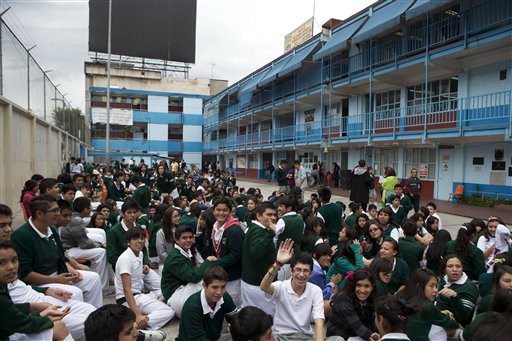ACAPULCO, Mexico (AP) — A strong earthquake shook the southern Pacific coast of Mexico as well as the capital and several inland states Thursday, sending frightened people into unseasonal torrential rains that were also bearing down on the coast.
The 6.4-magnitude quake in southern Guerrero state was centered about 9 miles (15 kilometers) north of Tecpan de Galeana, according to the U.S. Geological Survey, and was felt about 171 miles (277 kilometers) miles away in Mexico City, where office workers streamed into the streets away from high-rise buildings.
There were no reports of injuries. A 30-meter (yard) section of elevated road collapsed in Tecpan, near the epicenter, closing the federal highway between the resort cities of Acapulco and Zihuatanejo. The road had been damaged in a magnitude-7.2 quake that hit April 18 in roughly the same area and was under repair when it collapsed. The detour road was under water from the rains Thursday.
Tecpan shook ferociously, causing a “wave of panic” and some roofs to cave in, Mayor Crisoforo Otero Heredia said. As the day went on, civil protection workers started hearing of collapsed houses, some in remote areas in the municipality of Tecpan such as the town of La Cienega.
A wall collapsed in Chilpancingo, the capital of Guerrero state, but civil protection crews in Acapulco found no problems except scared citizens who were forced to take refuge in the heavy rain that was hitting the region.
In Mexico City, elegantly dressed businesswoman Carmen Lopez was leaving a downtown office building when the ground began to shake. She dashed across the street to a leafy median as light poles swayed violently above her.
“That was just too scary,” Lopez said as she quickly started dialing her cellphone to alert friends and family.
Behind her, thousands of people poured from neighboring office buildings, following pre-planned evacuation routes to areas considered safe in case of falling glass.
The quake occurred at a depth of 15 miles (23 kilometers) and its epicenter was about 40 miles (66 kilometers) from that of the April 18 quake that shook central and southern Mexico.
The earlier quake occurred in a section of the Pacific Coast known as the Guerrero Seismic Gap, which is a 125-mile (200-kilometer) section where tectonic plates meet and have been locked, causing huge amounts of energy to be stored up with potentially devastating effects, the USGS said. It said a magnitude-7.6 temblor struck in the section in 1911.
The U.S. agency said Thursday’s quake was an aftershock of the April 18 temblor.
“The earthquake is indeed within the Guerrero Seismic Gap,” USGS research geophysicist William Barnhart wrote in an email to The Associated Press. “But since it is consistent with being an aftershock of the magnitude-7.2, it is neither an abnormal event, nor does it significantly reduce the remaining stored stress in the seismic gap.”
The USGS says the Guerrero Gap has the potential to produce a quake as strong as magnitude 8.4, potentially much more powerful than the magnitude-8.1 quake that killed 9,500 people and devastated large sections of Mexico City in 1985. The 1985 quake was centered 250 miles (400 kilometers) from the capital on the Pacific Coast.
Mexico City is vulnerable to distant earthquakes because much of it sits atop the muddy sediments of drained lake beds. They jiggle like jelly when the quake waves hit.
___
Associated Press writer Mark Stevenson in Mexico City contributed to this report.

COMMENTS
Please let us know if you're having issues with commenting.